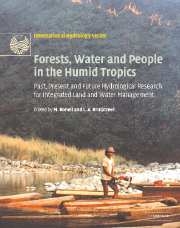 Forests, Water and People in the Humid Tropics
Forests, Water and People in the Humid Tropics from Part III - Forest disturbance, conversion and recovery
Published online by Cambridge University Press: 12 January 2010
INTRODUCTION
Hydrologists are facing important changes in the direction of their science. New tools, non-traditional datasets and a better understanding of the connection between land-surface hydrology and the rest of the climate system are being developed. Changes are so fundamental that a new agenda for land surface hydrology research has been proposed (Entekhabi et al., 1999).
One of the major challenges is related to large-scale hydrology. Part of this challenge is to reconcile the differences between two sciences. Large-scale hydrology is being studied typically by scientists with a background in hydrology or the atmospheric sciences, and the historical approach of each discipline is clearly present. Table 23.1 shows the different definitions of the spatial scales in common use. Here, we consider large-scale to be the scale between 100 and 10 000 km, a mix of the large catchment and continental scales of hydrology and a mix of synoptic and large scales found in atmospheric sciences.
Hydrologists and atmospheric scientists advanced into the new research field of large-scale hydrology a few decades ago: hydrologists scaled up their methods, atmospheric scientists scaled down their techniques. Of course there were conflicts caused by the different assumptions, jargon, orientations and methodologies used by the two sciences because of decades of separate development. Even so, the latter is hardly the beginning of the difficulties: in one of the pioneer essays in this area, Eagleson (1986) pointed out that large-scale hydrology has two characteristics that make it unique: interdisciplinarity and the presence of strong feedbacks.
To save this book to your Kindle, first ensure [email protected] is added to your Approved Personal Document E-mail List under your Personal Document Settings on the Manage Your Content and Devices page of your Amazon account. Then enter the ‘name’ part of your Kindle email address below. Find out more about saving to your Kindle.
Note you can select to save to either the @free.kindle.com or @kindle.com variations. ‘@free.kindle.com’ emails are free but can only be saved to your device when it is connected to wi-fi. ‘@kindle.com’ emails can be delivered even when you are not connected to wi-fi, but note that service fees apply.
Find out more about the Kindle Personal Document Service.
To save content items to your account, please confirm that you agree to abide by our usage policies. If this is the first time you use this feature, you will be asked to authorise Cambridge Core to connect with your account. Find out more about saving content to Dropbox.
To save content items to your account, please confirm that you agree to abide by our usage policies. If this is the first time you use this feature, you will be asked to authorise Cambridge Core to connect with your account. Find out more about saving content to Google Drive.